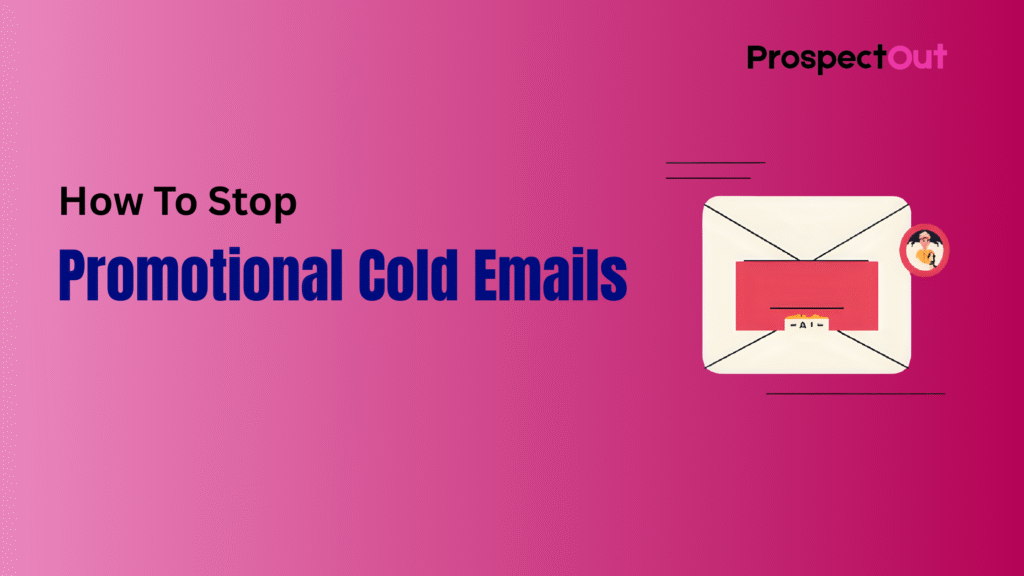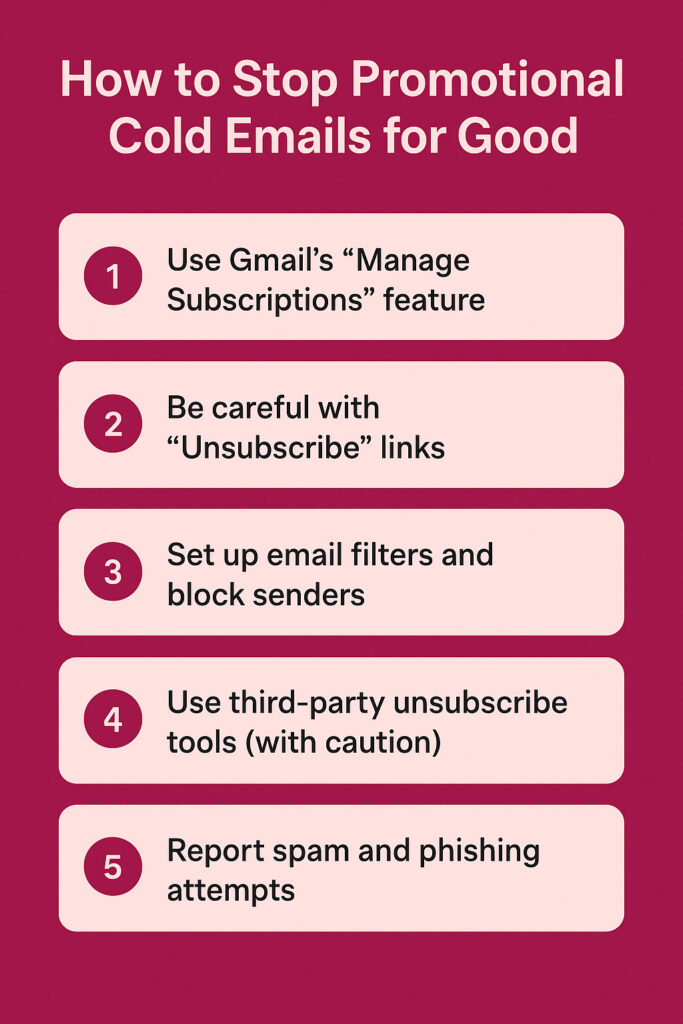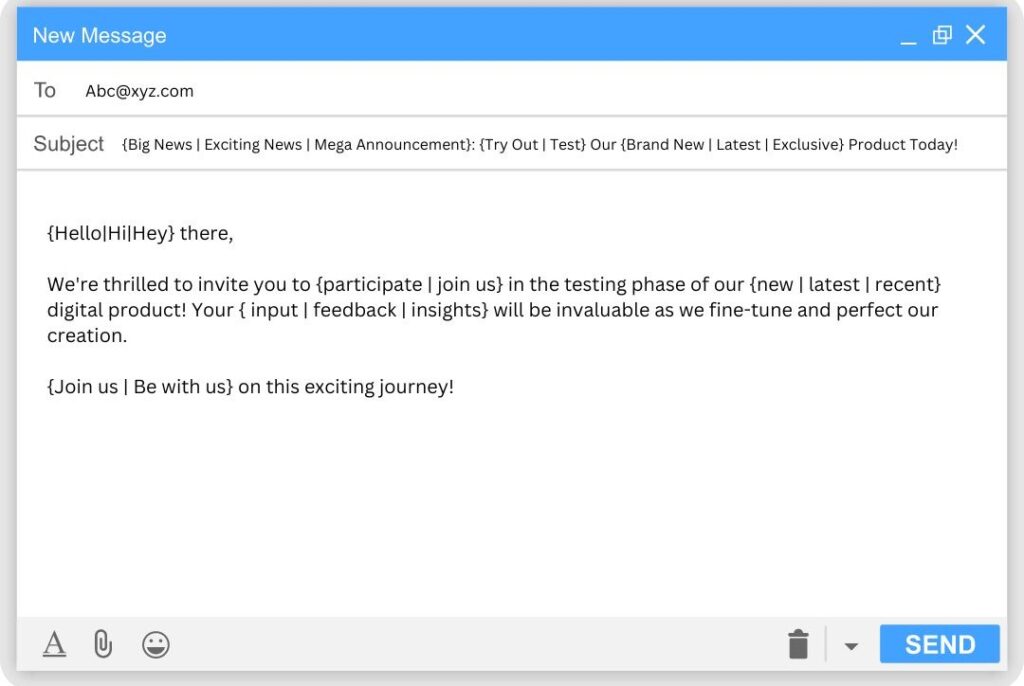
Promotional cold emails can be seriously annoying. You wake up, check your inbox, and bam!
There are a dozen emails from companies you’ve never heard of, all trying to sell you something you probably don’t need. Sound familiar?
If you’re tired of constantly deleting these emails (or worse, accidentally clicking on sketchy links), you’re definitely not alone. Luckily, there are some simple ways to stop these cold emails from piling up and disrupting your inbox peace.
I’m going to walk you through exactly how to take control of your inbox. Without turning it into a full-time job.
What Are Promotional Cold Emails Anyway?
First off, let’s clear up what we mean by “promotional cold emails.” These are emails you get from businesses or marketers trying to pitch products, services, or deals, but you never actually asked to get these emails.
Unlike spam, which is often untrustworthy or scammy, promotional cold emails can sometimes originate from legitimate companies. Just ones that got your email from somewhere, maybe without you really realizing it.
For example, you might get emails from a company you signed up for once, or maybe you gave your email out somewhere online, and now it’s making the rounds. Either way, they’re cluttering your inbox and making it harder to find the emails you actually care about.
Why Do You Keep Getting These Emails?
You might be wondering, “Wait, how do they keep getting my email if I never signed up for this stuff?” Good question! Here are a few reasons why:
- You accidentally opted in: Sometimes when you sign up for a freebie, contest, or online service from their prospect list, you might have checked a box that says “I agree to receive promotional emails,” without really noticing. Oops.
- Your info got shared or sold: Sadly, your email might have been shared between companies or sold to marketers who love sending cold emails.
- You can’t find the unsubscribe button: Some emails make it hard or even impossible to unsubscribe, so you just keep getting them.
- You didn’t unsubscribe properly: Sometimes you click unsubscribe, but the email sender isn’t legit, so it doesn’t actually stop the emails. It might even confirm to them that your address is active.
How to Stop Promotional Cold Emails for Good
Alright, here’s the good news: you’re not stuck with that messy inbox forever. There are some smart, simple ways to clean up your email and keep future promotional cold emails at bay.
1. Use Gmail’s “Manage Subscriptions” Feature (If You Use Gmail)
If you’re a Gmail user, you’re in luck! Gmail rolled out this handy feature that makes unsubscribing way easier. Instead of hunting for tiny “unsubscribe” links buried at the bottom of emails, Gmail gives you a central spot where you can see all your subscriptions in one place.
Here’s how it works:
- Open Gmail and look for the little “Manage subscriptions” option that appears near the top of promotional emails.
- Click it, and Gmail will show you a list of all the mailing lists you’re on.
- You can quickly unsubscribe from ones you don’t want without leaving your inbox.
It’s a real time saver and super user-friendly.
Why this rocks: You don’t have to open every single email to unsubscribe, and you’re less likely to fall for sketchy unsubscribe links.
2. Be Careful Clicking “Unsubscribe” Links
Now, here’s a tricky one, sometimes clicking “unsubscribe” can backfire.
Why? Well, if the email is from a spammer or scammer (not a legit business), clicking unsubscribe might just tell them your email is real and active. That can lead to even more junk coming your way.
So what should you do instead?
- Use Gmail’s unsubscribe feature (like above), or
- Mark the email as spam, and your email provider will learn to send similar emails straight to the spam folder.
- Block the sender directly.
Basically, only click unsubscribe links if you’re confident the sender is legit.
3. Set Up Email Filters and Block Senders
If you’re receiving numerous emails from the same sources, why not let your inbox handle the heavy lifting?
Most email services let you create filters that automatically sort, archive, or delete emails based on rules you set, like sender address, keywords, or subject lines.
Here’s a quick example for Gmail:
- Go to Settings > Filters and Blocked Addresses > Create a new filter.
- Type the email or domain you want to block (e.g., promotions@annoyingcompany.com).
- Choose what happens to those emails, like “Delete it” or “Skip Inbox.”
You can even create filters that move promotional emails into a separate folder so they don’t clog your main inbox, but you can check them later if you want.
Blocking senders is also an option. If someone’s emails are just plain annoying, block their address so you never see emails from them again.
4. Use Third-Party Unsubscribe Tools (With Caution)
There are some handy tools available, such as Unroll.Me that help you unsubscribe from tons of mailing lists all at once. They scan your inbox for subscription emails and provide a single place to unsubscribe in bulk.
Heads up though: These tools usually need permission to access your inbox, which raises privacy concerns for some people. Always read their privacy policy carefully before using one, and consider whether you’re comfortable with it.
5. Report Spam and Phishing Attempts
Your email provider has tools to help you fight back.
If an email looks suspicious or spammy, hit the “Report Spam” or “Report Phishing” button. This not only moves the email out of your inbox, but it helps improve filters for everyone.
Don’t just delete suspicious emails, reporting them makes a difference.

Bonus Tips for a Cleaner Inbox
Here are a few extra hacks to keep your inbox tidy going forward:
- Use a separate email for sign-ups: Consider setting up a dedicated email address for newsletters, online purchases, and sign-ups. Keep your personal email more private.
- Use disposable or temporary emails: For one-time registrations or trials, consider using temporary email services to avoid disclosing your real address.
- Regularly review your subscriptions: Make it a habit to review and update your subscriptions every few months.
- Enable two-factor authentication: This keeps your email account safer from hackers who could exploit your info.
Wrapping It Up: You Can Take Back Your Inbox
Promotional cold emails might feel like a never-ending flood, but with the right tools and habits, you can tame the chaos.
Start by using built-in features like Gmail’s subscription manager, be smart about clicking unsubscribe links, and make good use of filters and blocking. If you want, try a third-party tool. Just be careful with privacy.
Most importantly, don’t ignore spam or phishing emails. Report them so your provider can protect you better.
So, next time you open your inbox and see those pesky promotional cold emails, you’ll know exactly what to do. It might take a bit of time upfront, but soon enough, you’ll enjoy a cleaner, calmer inbox and a lot less email stress.


